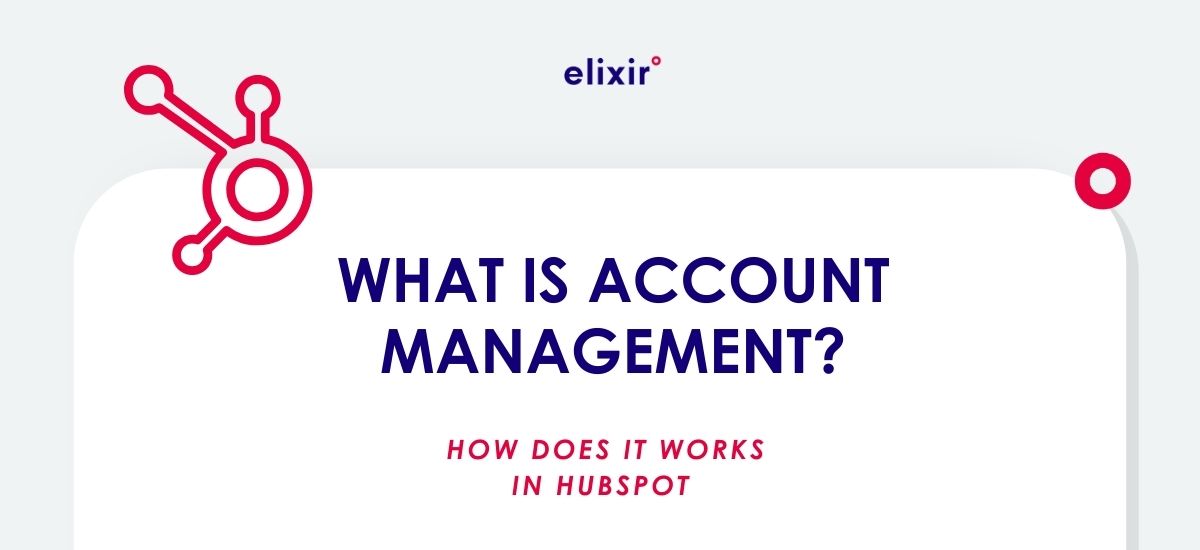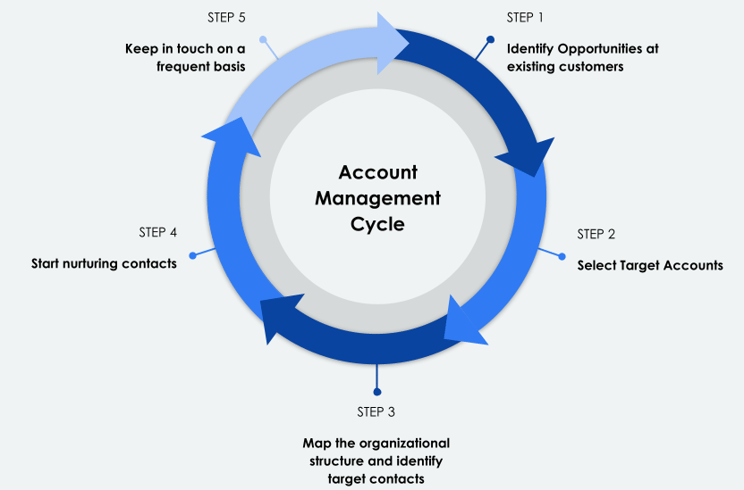WHAT IS ACCOUNT MANAGEMENT, AND HOW IT WORKS IN HUBSPOT

Effective account management plays a pivotal role in nurturing client relationships, ensuring client retention, and discovering opportunities for growth. Unlike traditional sales roles, which are often short-term and focus solely on acquisition, account managers serve as long-term liaisons and trusted advisors for their clients. In this blog post, we'll explore how to seamlessly integrate the Account Management Cycle into HubSpot, leveraging its powerful tools, including HubSpot CRM, Marketing Hub, and other relevant HubSpot features.
TABLE OF CONTENTS
Step 1: Identify opportunities at existing customers
Step 2: Select target accounts
Step 3: Map out organizational structure & identify target contacts
Step 4: Start nurturing contacts
OVERVIEW
With this definition in mind, here is a visual representation of the Account Management Cycle. We are going to see how to successfully set up each step of the cycle into Hubspot.

Source: https://www.lucidchart.com/blog/what-is-account-management
Step 1: Identify opportunities at existing customers
To begin, Account Managers must identify potential opportunities within their existing customer database. HubSpot provides a robust platform for this task, allowing Sales Representatives to filter companies using various criteria and save these filters for future reference. Some valuable properties to filter on include Company Owner, Industry, Country, Total Revenue, and Total Open Deal Value.
-
- Advanced Tip: Implementing a Scoring Model
For a more sophisticated approach, consider implementing a scoring model. Assign points to companies based on specific and relevant properties, which can vary depending on your industry and business sector.
By sorting companies based on their scores, Sales can prioritize those with the highest score, uncovering upsell and cross-sell opportunities.
Example:
-
- Industry = “Retail”: +10 p.
- Country = “NL”: +10 p.
- 3 or more open deals : +20 p.
- Up-sell and cross-sell opportunities
- Industry = “Retail”: +10 p.
Through reporting, it is possible to identify up-sell and cross-sell opportunities.
On the picture below, we can observe the relationship between the parent and child company, and the count of deals of each child company. This can be a potential opportunity for up-selling.
On the picture below, we observe the number of deals by company and product, enabling the possibility to cross-sell by proposing new products to existing customers.
Step 2: Select target accounts
Now that the opportunities have been identified, a selection of target accounts has to be made.
Once opportunities are identified, it's time to select target accounts within HubSpot. Sales Representatives can designate certain companies as "target accounts" to focus their efforts effectively. Under the "Contacts" section, you'll find a dedicated area for "Target Accounts," providing an overview of these accounts, including the number of deals, the buying committee, and more.
Navigate to Contacts > Target Accounts to provide the Sales department with an overview of their designated accounts, including deal counts, insights into the buying committee, and more.
Companies can be assigned to an “Ideal Customer Profile Tier” (can be automated, e.g. based on particular criteria).
A list of target accounts can then be filtered based on their tier.
Step 3: Map out organizational structure & identify target contacts
With target accounts in place, it's crucial to map out the organizational structure and identify key contacts. HubSpot enables the association of multiple contacts with a company.
Within the Account Overview, sales reps can assign a particular buying role (decision maker, influencer, end user, etc) to the contacts (see example below).
A valuable tool for visualizing contact relationships within an organization is the HubSpot add-on, OrgChartHub. This tool provides a clear organizational chart, mapping relationships between contacts and showing deal associations.
-
-
- Utilizing OrgChartHub, sales representatives can visualize the organizational chart, identifying and mapping relationships among contacts within a company. Additionally, they can track the number of deals associated with specific contacts
-
-
-
- "The 'Heatmap' visually highlights contacts with the most activity, offering a clear indication of where engagement is strongest. This not only aids in identifying valuable connections but also encourages proactive networking by leveraging existing contacts for introductions.
-
-
-
- Using the 'Account Mapping', sales reps can also visualize the relationships between various companies, and see the value of the open/closed deals for these companies.
-
Step 4: Start nurturing contacts
Once the right contacts within target accounts are identified, it's time to initiate contact and nurture these relationships. HubSpot offers a variety of outreach tools, including:
-
-
-
-
-
- Email templates
- Calling
- Meeting scheduler
- Tasks
- …
-
-
-
-
Additionally, sequences can be used for structured follow-up. A sequence consists of a series of emails and tasks scheduled within a defined timeframe. Contacts can be enrolled individually or in bulk, and sequences automatically stopped when a contact responds.
Step 5: Keeping in touch
After establishing initial contact and possibly closing deals, maintaining ongoing communication is essential for identifying future opportunities. HubSpot allows Sales Representatives to set contact frequencies (weekly, monthly, quarterly, yearly), which automatically generate tasks for follow-up.
By automating these tasks, Account Managers can efficiently track who to contact and when. An overview of all tasks is easily accessible in HubSpot's Sales section.
An overview of all tasks can be viewed by going to Sales > Tasks.
Sales will be notified via email of a new task assigned to them. They can click on the task and then start a task queue. This will take them from one task to another. Sales will then check the activity timeline and reach-out to the customer.
CONCLUSION
HubSpot offers a powerful platform to streamline and optimize the Account Management Cycle. By effectively identifying opportunities, selecting target accounts, mapping organizational structures, nurturing contacts, and maintaining regular communication, businesses can elevate their account management efforts to new heights, fostering lasting client relationships and driving growth opportunities.
By incorporating these strategies, HubSpot users can harness the full potential of their tools to excel in the crucial realm of account management.
Unlock the Power of HubSpot: Let's Elevate Your Marketing and Sales Together!

